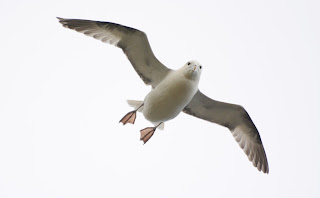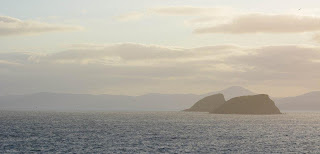Those of you who follow my blog
(is there anyone?) will know that during my recent ringing trip to America, I posted
updates as I was going along. I extend my sincere apologies to anyone who was
expecting the same thing from my recent trip ringing seabirds on the Shiants
Isles.
The Shiants Isles have to be one
of the most beautiful, atmospheric, mesmerising and unforgettable places I have
ever been to. They are incredibly peaceful, yet can be deafeningly noisy. They
are small and compact, yet full of mysteries. They are uninhabited, yet full to
bursting with life. Most of all, they are a challenge and they certainly live
up to their name; the ‘enchanted isles’.
The Shiants comprise three main
islands; House Island (where the bothy is), Rough Island and Mary Island. Rough
Islands hosts the main puffin colony, the auk bolder colony, the bonxies, many
of the gulls and shags and, if you are very lucky (I wasn’t), you might even
see a white-tailed eagle on there! House Island is home to more shags and
gulls, a few bonxies, a kittiwake colony, fulmars, smaller auk colonies and
black rats! Mary Island has another puffin colony and lots of gulls; I have yet
to visit this island.
 |
House Island in the distance with the boulder
colony at Carnach Mhor in the foreground |
 |
Rough Island - we climbed this in 40+ mph winds on two
consecutive days (and came down in driving rain on one of them) |
 |
| Mary Island from Rough Island |
Very few people have ever heard
of the Shiants Isles. This is because they are remote, located in the Hebrides
in north-west Scotland about twelve miles north of Skye and four miles from
Lewis. On a clear day you can see Skye, Lewis, Harris and mainland Scotland
from the islands. On a bad day, you can see none of the above! The islands are
uninhabited and have no running water, no electricity until dark when the
generator we take with us is switched on (and dark that far north in the summer
is late!), no ‘facilities’ and certainly no internet (except for patchy signal
on smart phones). Few people have heard of them because few people are ever
lucky enough to go there.
This year’s visit was my third
adventure to this magical place. Each year at the end of June and the beginning
of July, the Shiants Auk Ringing Group (SARG) spends two weeks ringing seabirds
on the islands. The journey starts with a boat trip on the wonderful Sea Harris
(http://www.seaharris.co.uk/) which
we meet at Uig on Skye; the trip takes about an hour and a half (if you head
straight there). This year the sea was a little choppy and I was beginning to
regret not having popped a travel pill when the islands loomed out of the mist
and both the sight of them and the promise of solid ground under my feet soon
had me smiling again. It wasn’t long
before we were anchoring offshore and relaying everyone and everything we needed
for the duration of the trip to the beach in a RIB and lugging it all to the campsite
and bothy. After a much needed cuppa, it was all hands on tents as we battled
the strong winds to get our tents up before the rain arrived.
 |
| Lovely dry tent ready to take on the worst the Minch has to offer |
So, what do we go there to ring? Well, the islands are home to many thousands of birds but the primary focus for SARG is the auks. We undertake two RAS (Re-trapping Adults for Survival) projects, one on puffins and one on razorbills. We also try to ring as many razorbill chicks as possible. We ring guillemots (adults and chicks) and we colour ring the shags, bonxies (great skuas) and gulls (common, lesser and great black-backed). We ring any waders we find (and can catch) and we ring any storm petrels that we can persuade to come and visit us (by sound lure). We also try to ring the arctic tern chicks in the colony on Fladaigh Chuain, another small, uninhabited island that we visit en route to or from the Shaints. That is the theory anyway!
 |
Puffin RAS slope with Lewis in the
background (it is a bit steep up there!) |
 |
| Puffin in mist net |
This year’s trip was slightly
different. Those of us on the second week of the trip were watching the weather
forecast with interest from the moment we heard that the first week’s team were
sailing on the Saturday rather than Sunday morning in order to dodge the wind.
Hmmm, not an auspicious start! News then trickled through that not all of the
birds had read the manual on when to breed. Things were late and there weren’t
many auk chicks about. Then we heard that we might also be sailing on the
Saturday instead of Sunday; then it was back to Sunday; then it was definitely
get to Uig on Saturday just in case; then it was we are definitely going on the
Saturday evening! Things were a little changeable – good old British weather!!!
But, we made it over to the islands on Saturday evening and we were all set up
and raring to go a day before we expected to be so we were a happy bunch of
campers.
Then the rain came… and kept on
coming. And then the winds came to join the party. The Minch had decided to
test out our camping gear! Unfortunately, some were left wanting but I was one
of the lucky ones who had a strong, waterproof and cosy home for the week. I
love my tent! So, Sunday was a complete washout, which I was actually not too
sorry about as I had arrived on the islands somewhat shattered so a day of
doing nothing was just what I needed. After all, we had the rest of the week to
blitz the ringing… didn’t we?
Well, actually no, not quite.
This year the Hebrides decided to throw everything at us; gale force winds,
driving rain, cold…you get the picture. But did we let it stop us? Of course
not, we are ringers after all! When the RIB wouldn’t work, we just walked into
the bolder colony. When it was too windy to drive the RIB, we walked over the
top of Rough Island to get to where we needed to be. When the storms threatened,
we hunkered down and waited them out. When the winds were too strong to keep
mist nets up… well, then we took them down, sulked a little and admitted
defeat!
 |
Juvenile (last year's young) razorbill above and comparison of
wings with an adult bird below |
Despite the weather, we
successfully managed to undertake both RAS projects, ringed as many of the gull
chicks as we could find, spent a fair amount of time in the boulder colony and
so on. However, the provisional ringing totals for 2013 suggest that we ringed
significantly fewer birds this year than during the previous two trips that I
have been on, which was for the most part due to the lack of ringable chicks.
Whereas we would normally ring c. 500 razorbill, guillemot and shag chicks,
this year we managed approximately 30! For some reason, these birds (and the
bonxies) were late breeding this year (or seemingly hadn’t attempted to breed in
the case of the shags). Those that had bred, were mostly still on eggs and the
young that were around were mostly too small to ring. Strangely, the puffins,
gulls, waders and terns all seemed to be on time with their breeding. Sadly,
the storm petrels were also conspicuous by their absence. Despite three
attempts over the two weeks, only four birds were caught. We put up a net on
our last night (the only night calm enough to try) but sadly, to no avail.
 |
| Common gull chick |
On Wednesday, a team from the BBC
Coast programme joined us to film the puffin RAS and talk to Ian and David (two
of the original members of the SARG) about old puffins. We managed to find them
a 30 year old, which they seemed quite pleased about!
 |
| Coast crew filming Ian on puffin RAS slope |
 |
The team with the BBC Coast crew on the last day (thanks to
Charlie E for the photo) |
As is typical, our last evening
on the islands was glorious which gave us chance to visit the lesser
black-backed colony (only three chicks found) and gave me the chance to try to
snap some photos of the elusive black rat. The trip home on Sunday was flat
calm (surreally so) which meant we could land on Fladaigh Chuain to ring
the arctic tern chicks, a few shag chicks and, much to Ian’s delight, a single
black guillemot (tystie) chick. Hearing the tysties calling / singing so close
was an experience I won’t forget in a hurry!
 |
Black rats. If you look closely, you might just be able to see
the peanut butter lure |
 |
| Arctic tern chicks |
 |
| Black guillemot (tystie) chick and egg |
 |
| Beautiful tysties on Fladaigh Chuain |
 |
| Shag on Fladaigh Chuain |
 |
| The Sea Harris with the Shiants Isles behind |
 |
| The Shiants Isles from Fladaigh Chuain |
So, all in all, this year’s trip
was dominated by the weather and the late breeding season. Despite the
challenging conditions it was (as always) a fantastic week which was thoroughly enjoyed by all of us. Roll on next year!
























































































